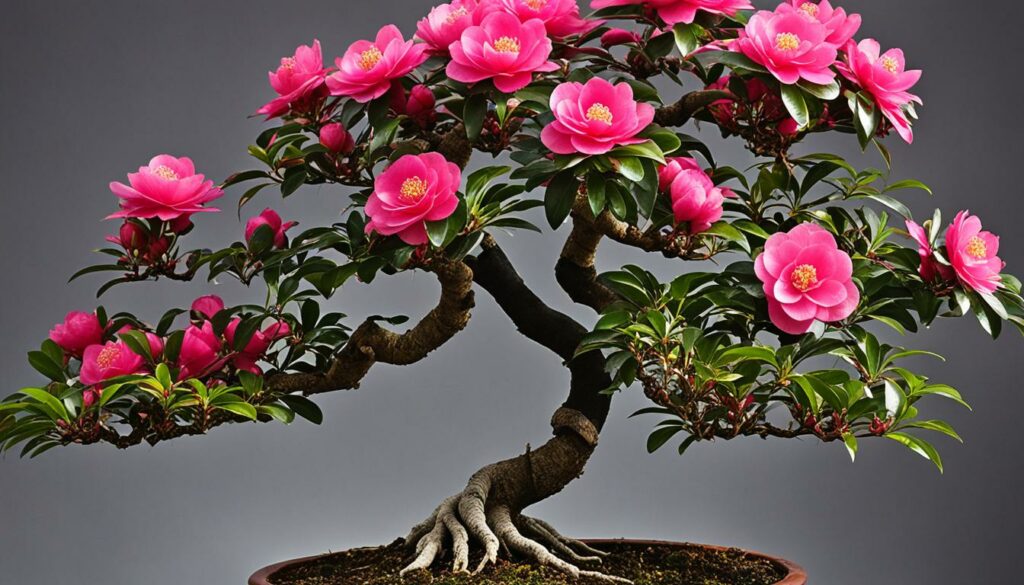If you’re searching for a stunning flowering bonsai species, look no further than the Camellia. This evergreen beauty adds elegance and grace to any bonsai collection, and its vibrant blooms can blossom year-round.
Key Takeaways:
- Camellia bonsai trees are known for their stunning flowers and glossy evergreen foliage.
- Choosing the right Camellia variety will depend on personal preferences and growing conditions.
- Proper potting, pruning, watering, and fertilization are crucial for the health and development of your Camellia bonsai.
- Camellias require specific care depending on the season, and preventive measures must be taken against pests and diseases.
- Camellia bonsai trees hold cultural significance in Japan.
What is a Camellia Bonsai?
A Camellia bonsai is a beautiful and miniature version of the Camellia tree – a tree known for its gorgeous flowers and a lush green appearance. This bonsai species is a popular choice among enthusiasts, and its year-round blooming feature is admired by many. Camellia bonsai trees are grown for their delicate, bright, and showy flowers that add elegance to any indoor or outdoor space. Their glossy leaves are evergreen, making them a great option for year-round decoration.
Camellia bonsai trees are a common sight in many households and gardens worldwide. They make perfect gifts for those who are passionate about bonsai trees, gardening, or nature. If you are an amateur or an experienced bonsai tree cultivator, adding a Camellia bonsai tree to your collection is a wonderful idea.
Camellia Bonsai: An Overview
| Common name | Scientific name | Family | Origin |
|---|---|---|---|
| Camellia Bonsai | Camellia japonica or Camellia sasanqua | Theaceae | Japan, Korea, China, Southeast Asia, and India |
| Camellias are widely popular and grown worldwide as ornamental plants. |
Camellia bonsai trees are part of the Theaceae family and are native to Japan, Korea, China, Southeast Asia, and India. They have been grown for centuries for their ornamental value. They are known for their beautiful and showy flowers and evergreen foliage. There are several varieties of Camellia bonsai trees available, with slight differences in their flower and foliage characteristics.
Tip: When it comes to selecting a Camellia bonsai tree, make sure that you choose the right variety suitable for your growing conditions and preferences. The two main varieties of Camellia bonsai are Camellia japonica and Camellia sasanqua, each with its unique features and requirements.
Characteristics of Camellia Bonsai
Camellia bonsai trees are a popular choice among bonsai enthusiasts due to their unique characteristics, including vibrant flowers and evergreen foliage. The shiny, dark green leaves of Camellia bonsai trees provide a consistent source of beauty in your display, and the colorful flowers add a touch of elegance that is perfect for any setting. As an evergreen bonsai species, Camellia bonsai trees retain their foliage throughout the year, ensuring that your display will remain stunning no matter the season.
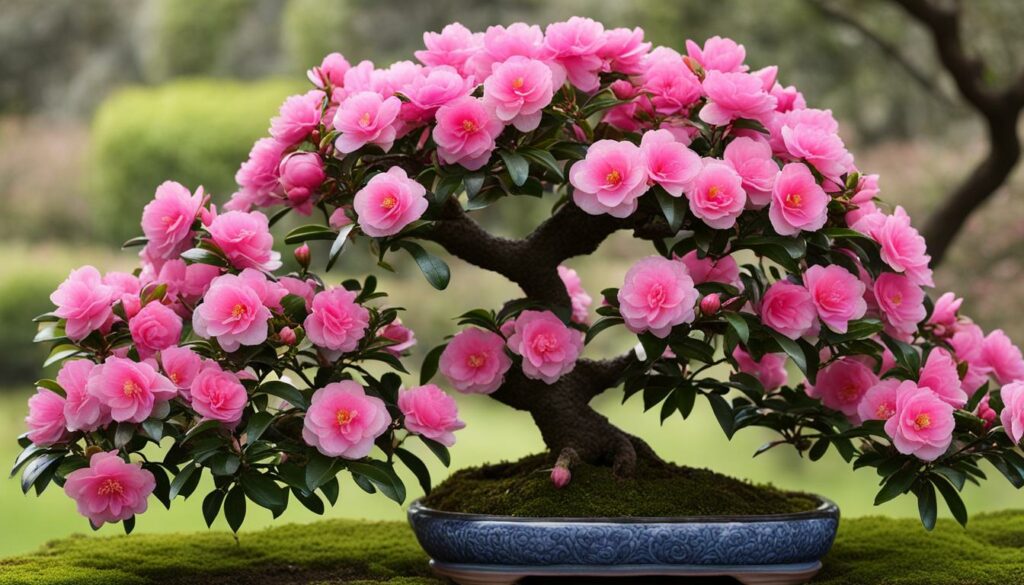
Choosing the Right Camellia Variety
When it comes to selecting a Camellia variety for bonsai cultivation, there are numerous options to choose from. Each variety offers unique characteristics and flower colors, making it essential to select the right one based on your personal preferences and the growing conditions in your area.
For bonsai cultivation, the Camellia sasanqua and Camellia japonica are popular choices due to their beautiful flowers and evergreen leaves.
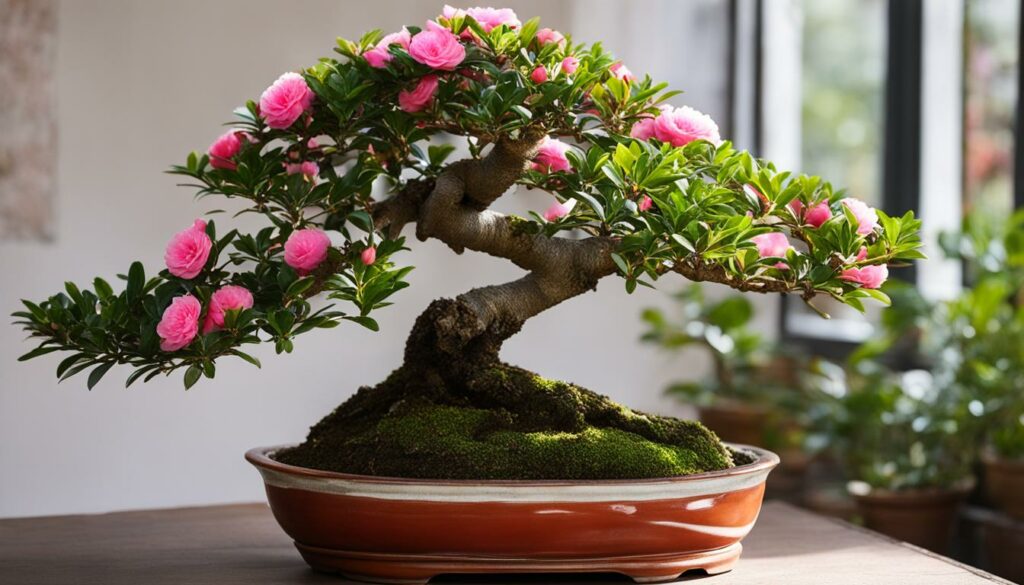
The Camellia sasanqua is a hardy evergreen bonsai that produces delicate, white to pink flowers in the fall and winter months. Its leaves are glossy, dark green and slightly fragrant, making it an excellent choice for bonsai enthusiasts who appreciate a sweet aroma.
The Camellia japonica, on the other hand, is renowned for its large, showy flowers, which come in various colors, including pink, red, and white. This evergreen bonsai blooms in late winter and early spring, making it an ideal choice for those seeking a splash of color during the colder months.
Other varieties worth considering for Camellia bonsai cultivation include:
- Camellia sinensis, known for its tea leaves
- Camellia reticulata, giant flowers, and glossy leaves
- Camellia hiemalis, winter hardy and abundant blooms
| Variety | Flower color | Blooming season | Leaf color |
|---|---|---|---|
| Camellia sasanqua | White to pink | Fall to winter | Glossy, dark green |
| Camellia japonica | Red, pink, white | Late winter to early spring | Glossy, dark green |
| Camellia sinensis | White | Spring | Dark green |
| Camellia reticulata | Red, pink, white | Late winter to early spring | Glossy, dark green |
| Camellia hiemalis | White, pink | Winter | Glossy, dark green |
Take the time to research and compare different Camellia varieties before selecting the right one for your bonsai collection. It can make all the difference in achieving the desired look and growing success.
Potting and Repotting Camellia Bonsai
One of the most important aspects of caring for your Camellia bonsai is proper potting and repotting. Camellias have a shallow root system, which means they require a shallow container and well-draining soil to thrive.
When selecting a pot for your Camellia bonsai, choose a container with a diameter slightly larger than the current root ball. Avoid using a pot that is too large, as it can lead to overwatering and root rot. A suitable potting mixture for Camellia bonsai includes a blend of organic and inorganic materials, such as akadama, pumice, and peat moss.
Repotting your Camellia bonsai should be done every two to three years, either in early spring before new growth emerges or in mid-summer after the blooming season has ended. Carefully remove the bonsai from its old pot and trim off any unhealthy or tangled roots. Repot the bonsai in fresh soil, ensuring the root ball is level with the top of the pot.
Tip: Avoid fertilizing your Camellia bonsai for at least two to three weeks after repotting to prevent root burn.
Potting and Repotting Camellia Bonsai Table
| Task | Timing | Tools/Supplies Needed |
|---|---|---|
| Choose a suitable pot | Initial planting and each repotting | Pot with drainage holes, mesh screen, bonsai soil mixture |
| Prepare the bonsai for repotting | Every two to three years | Pruning shears, root rake, chopsticks |
| Remove the bonsai from its pot | During repotting | Bonsai soil scoop, chopsticks |
| Trim the roots | During repotting | Pruning shears, root rake |
| Repot the bonsai in fresh soil | During repotting | Bonsai soil scoop, chopsticks |
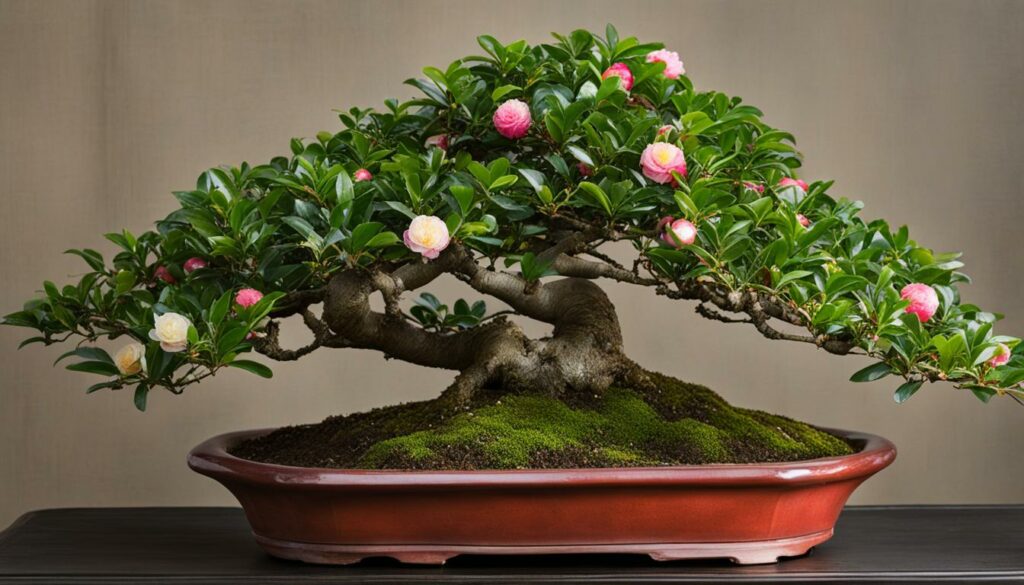
Pruning and Shaping Camellia Bonsai
Pruning and shaping your Camellia bonsai is an essential part of maintaining its compact size and aesthetic beauty. Regular trimming promotes the growth of new buds and encourages the plant to produce vibrant flowers. Here are some techniques for shaping your Camellia bonsai:
- Pinching: This involves using your fingertips to pinch off the new growth, encouraging the plant to grow in the shape that you want.
- Wiring: This technique involves wrapping wire around the branches and gently bending them into the desired position. Be careful not to damage the branches or bark while wiring.
- Pruning: Consider trimming off damaged or dead branches. You can also prune to promote specific growth, such as encouraging more flowers by trimming back to a node below the bloom.
- Canopy shaping: Depending on the style of your bonsai, you may need to shape the canopy by trimming the outer branches while leaving the inner branches untouched.
Remember to prune your Camellia bonsai during the growing season, as it promotes growth and helps the plant stay healthy. Enjoy the art of shaping and creating a beautiful Camellia bonsai display.
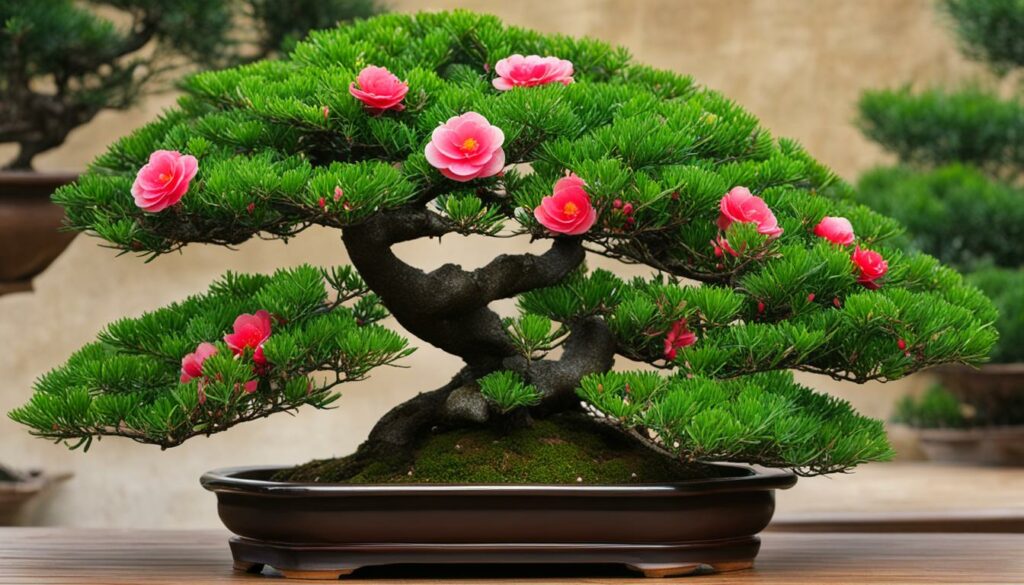
Watering and Fertilizing Camellia Bonsai
Proper care for your Camellia bonsai includes consistent watering and fertilization to promote healthy growth and vibrant blooms. Here are some key tips:
Watering Your Camellia Bonsai
Camellias require moist soil but are sensitive to overwatering, which can lead to root rot. It’s crucial to establish a watering routine and stick to it. Your Camellia bonsai will require more frequent watering during hot, dry weather and less during cooler seasons. Test the moisture level of the soil with your finger and water when the top inch feels dry. Avoid watering the foliage, as this can lead to disease.
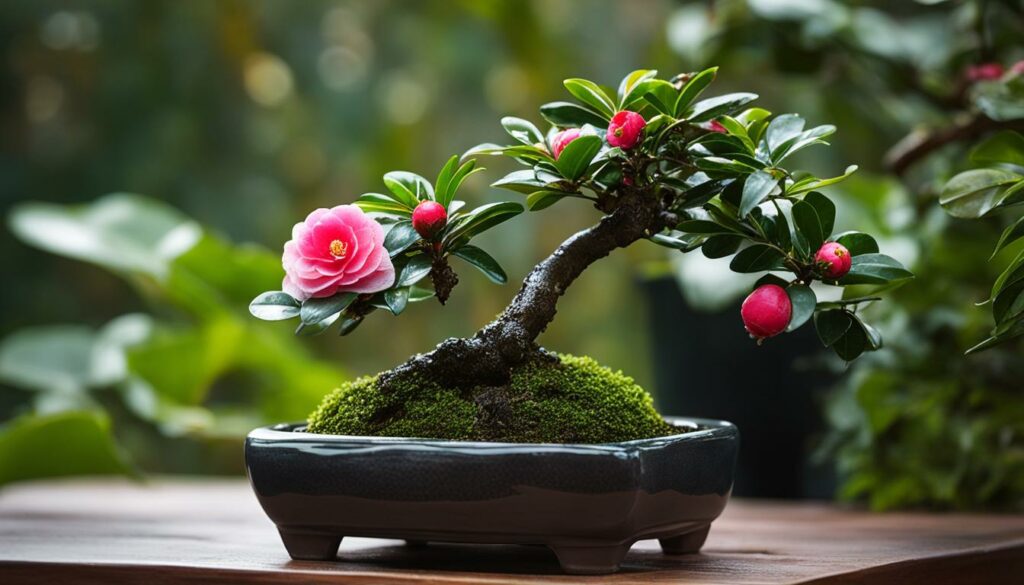
Fertilizing Your Camellia Bonsai
Fertilization is essential to provide the necessary nutrients for your Camellia bonsai to thrive. Use a balanced fertilizer with equal parts nitrogen, phosphorus, and potassium, applied every four to six weeks during the growing season. Avoid feeding during winter or dormant periods as this could cause damage to the roots. Over-fertilization can lead to salt buildup, which can harm your bonsai. Choose a high-quality fertilizer specifically designed for bonsai trees to ensure the proper balance of nutrients.
Camellia Bonsai Care During Different Seasons
As an evergreen bonsai species, Camellia bonsai trees require particular care depending on the season. Ensuring proper care year-round will help your bonsai thrive and produce stunning blooms.
Winter Care
During winter, Camellia bonsai trees need adequate protection from frost and freezing temperatures. Consider moving your bonsai to a warmer location or covering it with a protective layer to shield it from the cold.
Summer Care
In the hot summer months, Camellia bonsai trees require ample hydration and shading from direct sunlight to prevent heat stress. Increase watering frequency and ensure proper drainage to avoid waterlogged soil. Consider placing your bonsai in a location with partial shade to shield it from harsh sunlight.
Spring and Fall Care
In the transition periods of spring and fall, your Camellia bonsai will require regular maintenance to promote healthy growth and blooming. Prune any dead or damaged branches and adjust watering frequency to suit changing weather conditions. Use a balanced fertilizer to provide essential nutrients to your bonsai.
Pests and Diseases of Camellia Bonsai
Although Camellia bonsai trees are known for their resilience, they can still fall victim to a range of pests and diseases. It’s important to keep a watchful eye on your bonsai and notice any signs of distress or damage. Here are some common pests and diseases that can affect Camellia bonsai:
Pests:
| Pest | Signs of Infestation | Treatment |
|---|---|---|
| Aphids | Curling or yellowing foliage, sticky residue on leaves | Spray with insecticidal soap or neem oil |
| Spider Mites | Fine webbing on leaves, bronze stippling on foliage | Spray with horticultural oil or insecticidal soap |
| Scale Insects | Small brown bumps on stems or leaves | Apply rubbing alcohol with a cotton swab, or spray with neem oil |
Diseases:
- Phytophthora root rot: This fungal disease causes root rot, yellowing leaves, and stunted growth. It can be prevented by using well-draining soil and avoiding overwatering. Infected plants should be removed and the soil treated with a fungicide.
- Camellia petal blight: This fungal disease causes flowers to turn brown and fall off prematurely. It can be prevented by removing infected flowers and keeping the soil and leaves dry.
- Bacterial Leaf Blight: This bacterial disease causes brown spots on the leaves and flowers. It can be prevented by avoiding overhead watering and removing affected leaves and flowers.
Remember to regularly inspect your Camellia bonsai and keep it healthy by providing proper care and promptly addressing any issues that arise.
Displaying and Exhibiting Camellia Bonsai
After investing time and effort cultivating your Camellia bonsai, you’ll want to display it effectively. There are various ways to showcase your bonsai, depending on your preferences and the overall aesthetics of your space.
Bonsai stands are a classic choice, elevating your Camellia bonsai to a position of prominence and allowing easy viewing from all angles. You can choose from wooden, ceramic, or metal stands, depending on your preferred style and budget.
Another method is combining your Camellia bonsai with accent plants. Display your Camellia alongside plants in complementary colors or textured foliage to create a visually striking composition.
If you’re looking to exhibit your Camellia bonsai in shows or competitions, pay attention to the event’s rules and guidelines. Ensure your Camellia bonsai is in its best condition by grooming it thoroughly and selecting the right pot and accessories.
Pro Tip: To create an eye-catching display, choose a unique container for your Camellia bonsai. Experiment with different shapes and colors or recycled materials to showcase your creativity and personal style.
Whichever display method you choose, ensure it allows your Camellia bonsai to shine. Take cues from Japanese bonsai culture by incorporating minimalist design elements and emphasizing organic beauty.
Camellia Bonsai in Japanese Culture
The Camellia bonsai holds a special significance in Japanese culture. In Japanese, the Camellia is called “Tsubaki” and is often associated with devotion, passion, and perfection.
The Camellia flower’s bloom symbolizes the arrival of spring, and it has long been cherished in Japan for its beauty and elegance. It is often used in tea ceremonies, where its delicate petals and scent convey a sense of calm and serenity.
The Camellia bonsai is also significant in Japanese art and literature. It is frequently depicted in paintings, poetry, and other forms of art, showcasing its timeless beauty and cultural importance.
The Legend of the Camellia
“The Camellia is believed to have originated in China many centuries ago. According to legend, the Camellia flower was named after a Jesuit priest who traveled to China in the 16th century. His name was Georg Kamel, and he was a botanist who discovered the Camellia plant and brought it back to Europe. Today, the Camellia is widely cultivated in Japan and other parts of the world.”
Conclusion
The Camellia bonsai is not just a work of art or a plant to cultivate; it represents a culture and a tradition that dates back centuries. Its beauty and elegance have captured the hearts of people worldwide, and its legacy continues to bloom. If you want to experience the rich history and cultural significance of the Camellia bonsai, then adding it to your bonsai collection is a must.
Conclusion
Now that you have explored the captivating beauty of the Camellia bonsai species, it’s time to start your journey as a bonsai cultivator. By understanding the characteristics, care requirements, and display options of the Camellia bonsai, you can create a stunning masterpiece that blossoms year-round.
Remember, Camellia bonsai trees are evergreen and flowering bonsai species that require proper potting, pruning, watering, fertilizing, and seasonal care. Choose the right Camellia variety that suits your preferences and growing conditions, and follow the recommended guidelines to ensure your bonsai has the optimal growing environment.
Once you have mastered the art of cultivating and caring for your Camellia bonsai, you can showcase your masterpiece using different display options, such as bonsai stands, accent plants, and exhibitions.
Lastly, don’t forget that Camellia bonsai holds a significant place in Japanese culture and symbolism. These bonsai species are revered for their beauty, elegance, and year-round flowering. Embrace the art of bonsai and start your journey with the elegant Camellia bonsai.
FAQ
What is a Camellia Bonsai?
A Camellia bonsai is a miniature version of the Camellia tree, known for its stunning flowers and glossy foliage. It is a popular choice among bonsai enthusiasts due to its ability to produce vibrant blooms year-round.
What are the characteristics of Camellia Bonsai?
Camellia bonsai trees are characterized by their shiny, dark green leaves and abundant, colorful flowers. As an evergreen bonsai species, Camellias retain their foliage throughout the year, providing a consistent source of beauty in your bonsai display.
How do I choose the right Camellia variety for bonsai cultivation?
There are several Camellia varieties suitable for bonsai cultivation, such as Camellia sasanqua and Camellia japonica. The right variety depends on your personal preferences and the growing conditions in your area.
What should I consider when potting and repotting Camellia Bonsai?
Proper potting and repotting are crucial for the health and development of your Camellia bonsai. You need to use suitable potting mixtures, follow repotting intervals, and employ techniques to ensure optimal growth conditions.
How do I prune and shape Camellia Bonsai?
Pruning and shaping your Camellia bonsai is essential to maintain its compact size and desired aesthetic. You need to learn the key techniques for pruning branches, shaping the canopy, and encouraging the growth of new buds and flowers.
What is the proper way to water and fertilize Camellia Bonsai?
Proper watering and fertilization are vital for the overall health and vitality of your Camellia bonsai. You need to establish a watering routine, select the right fertilizers, and maintain the right balance of moisture and nutrients for optimal growth.
How do I care for Camellia Bonsai during different seasons?
Camellias require specific care depending on the season. You need to follow seasonal care guidelines, including winter protection, summer heat tolerance, and spring and fall maintenance tasks.
What are some common pests and diseases of Camellia Bonsai?
Despite their resilience, Camellia bonsai trees can be susceptible to a few pests and diseases. You need to learn to identify common issues, implement preventive measures, and apply appropriate treatment to maintain the health of your bonsai.
How should I display and exhibit Camellia Bonsai?
Displaying your Camellia bonsai is an art in itself. You can showcase your bonsai using traditional methods such as bonsai stands and accent plants, or you can exhibit your Camellia bonsai in shows and competitions.
What is the significance of Camellia Bonsai in Japanese culture?
Camellias hold a significant place in Japanese culture and symbolism. Camellia bonsai trees are revered for their beauty and elegance in Japan.
